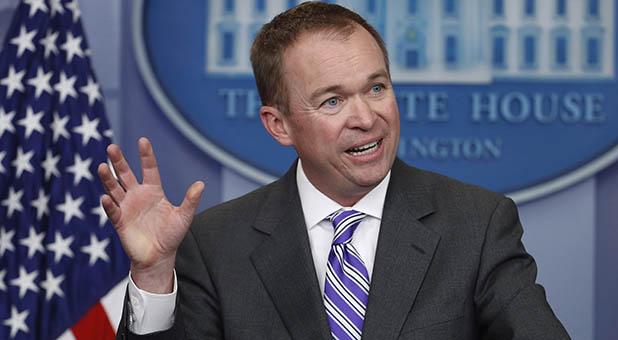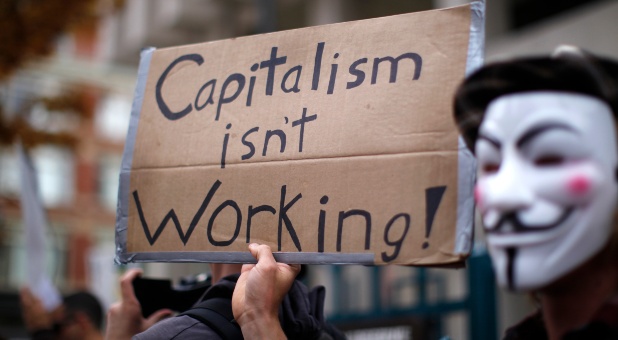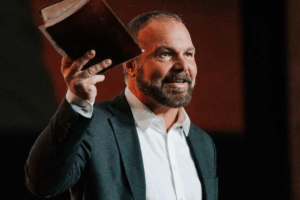Office of Budget & Management Director Mick Mulvaney briefed reporters Tuesday night on President Donald Trump’s more detailed plan to reduce the size and cost of government and to improve its efficiency.
“What kicks in tomorrow is what we call the smart hiring plan,” he said. “Right now, if you are the Department of Energy, you haven’t been able to hire anybody because of the freeze that we put in place on day one …
“But, as soon as the guidance goes out, what we expect the Department of Energy to do—along with all the other agencies—is look at that guidance and say, ‘OK, here are the president’s priorities as contained in the budget; it seems like the president wants us to beef up this particular operation at the Department of Energy and reduce our emphasis on this particular department—or organization within the Department of Energy.’ So they would hire more over here and fewer over here.
“So what the guidance really does is tell them, look to the budget blueprint and fashion your hiring and the paring down of your workforce consistent with the budget.”
The following is his whole statement about the new Smart Hiring Plan:
Tomorrow, in the morning, we will be releasing our guidance related to the executive order on the government restructuring. Why should anybody care about that? This marks a couple of different things.
First of all, it’s a major accomplishment for the administration in the first 100 days. It’s something we said we were going to do on Day One, and we’re following through well within the end of the 100-day period. More immediately, perhaps, the government hiring freeze will end with the release of this guidance. That does not mean—and I’ve made this very clear to all of the agency heads, the deputy chiefs, and so on, for the last couple of days—that does not mean that the agencies will be free to hire willy-nilly.
What we’re doing tomorrow is replacing the across-the-board hiring freeze that we put into place on day one in office, and replacing it with a smarter plan, a more strategic plan, a more surgical plan. And what that means specifically is that, consistent with the president’s priorities in the budget, certain agencies will end up hiring more people. Other agencies will end up paring their FTEs even greater than they would have had during the hiring freeze.
So we’re going from this sort of across-the-board hiring freeze. That’s not unusual for any new management team to come in—to put into place when they come into an organization, whether it’s the private sector or a government. Not unusual for a new management team to come in and say, look, stop hiring, let us figure out what’s going on, we’ll get acclimated and then we’ll put into place something that’s more practicable and smarter. And that’s what this is. So you’ll see this across-the-board ban tomorrow and replaced with a smarter approach.
To the larger issue, the government reorg is probably the biggest story that nobody is talking about. Yes, we talk about health care; yes, we talk about taxes; yes, we talk about infrastructure—and all of those are extraordinarily critical to rebuilding the country, making America great again, as the president has said. This is something that goes much deeper and to the very structure of government.
This is trying to do something that has never been done before. The executive branch of government has never been rebuilt. It has grown organically over the course of the last 240 years, and the president of the United States has asked all of us in the executive branch to start from scratch, a literal blank piece of paper and say, if you’re going to rebuild the executive branch, what would it look like.
One of the things we’re doing for the first time ever, we think, is soliciting a lot of input from outside. You go to the website, the WhiteHouse.gov website and see a—what I’m told is not a completely terrible—I thought it was awful—video that I made on there, soliciting input from individuals—like to say, look, if you’ve had a contact with a federal government that you think could go better, tell us about it. If you’re an academic and you’ve got an idea on how to fix the government, tell us how to do it, give us the ideas. So we’ve got a website set up for that.
We met this morning with CEOs from all across the nation and said, look, we’re trying to do something that’s never been done, we’re trying to rebuild the executive branch of government, give us some ideas. By the way, they did. And one of the ideas I took away from that meeting this morning was a suggestion from the group of business leaders that says, look, why don’t you restructure the government in terms of the functions that it performs. Instead of following some organically created guidelines over the course of the last two centuries or instead of following the 12 appropriations committees on the Hill, go and look at the functions.
Does the government want to be in the business of trade? OK, then let’s go find all of the functions of government that deal with trade and put it in one place. The best example I can think of is workforce training, and the number I have—always stuck in my head—is we have 43 different workforce training programs spread across at least 13 different agencies.
Now, there’s a rule in the private sector which is that if everybody is responsible, nobody is responsible. And that’s what we face right now all too often in the executive branch. If the President, for example, wants to know why the federal government workforce training programs aren’t functioning as best as they possibly can, there’s no one person he can turn to and say, why is that, and shouldn’t we be able to fix that. And that’s one of the things that we’ll be looking for.
We think at the end of the day this leads to a government that is dramatically more accountable, dramatically more efficient, and dramatically more effective, following through on the very promises the President made during the campaign and that he put into place on day one …
We’ve gone out to the agencies with this and say, why don’t you, by the way, you give you your ideas on how you can improve your agency. If you’ve always had an idea why NASA should be in the Department of Agriculture, now is your time to speak up. Okay, this is a blank piece of paper, and we ask all the agencies to come back to us. So between June and September, we’ll be collecting that data from the agencies. And then, in September, we’ll be starting to go back to the President and say, look, here are some of the ideas with a goal towards putting these things into place roughly 11 months from today.
After making his statement, Mulvaney took a few questions from the media. During that Q&A, he was asked how this plays into the president’s “drain the swamp” plans, as well as how the president intends to succeed where others—including presidents Reagan and Clinton—had failed.
“This is really important to the president,” he said. “I wasn’t around the Clinton administration, I don’t remember the Reagan administration, but I can tell you that this is a big part of draining the swamp. We focus on things like getting lobbyists out of the process, and the five-year ban, and all that—and that’s certainly part of the draining the swamp—but really what you’re talking about doing is restructuring Washington, D.C., and that is how you drain the swamp.
“So the president uses different words. He doesn’t use the words ‘restructuring government,’ ‘reorganizing government,’ he uses the words ‘drain the swamp.’ But that’s what this is. So this is a centerpiece of his campaign and a centerpiece of his administration.” {eoa}
See an error in this article?
To contact us or to submit an article





















